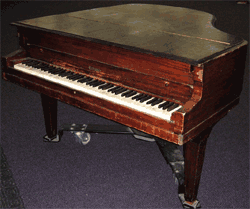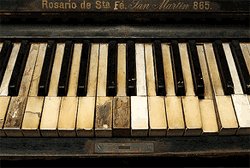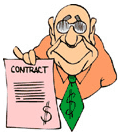Antique Piano Restoration
Home » Piano Info » Antique Piano Restoration
Instead of buying a new piano we can take an old one and give it a new life by performing piano refinishing or restoration.

Why would we do such a thing?
First of all, it will cost much less to restore a piano, than buying a new one. The piano may be antique, with missing keys, broken frame etc, but if it was made by a good manufacturer it will probably be worthwhile to take it to a professional piano restorer who can bring it back to life!
 Old, out of tune, broken pianos may be of sentimental value to the some families. Throwing it out is something they just won't do, so they
prefer to renew its parts and bring the piano back to good playing condition.
Old, out of tune, broken pianos may be of sentimental value to the some families. Throwing it out is something they just won't do, so they
prefer to renew its parts and bring the piano back to good playing condition.
Antique Piano restoration is a great issue when we are talking about antique pianos. This world of antique pianos is fascinating, and I would like to expand a little bit about them since many of them are candidates to be restored.

Pianos are considered to be antiques if they are at least 100 years old. In those days pianos were considered a centre-piece - adding style and atmosphere to the home. Antique pianos were handmade by craftsmen who were dedicated to their handicraft and related to pianos as a piece of art.
They built unique pianos with high quality materials, giving them a special look and feel, and a beautiful sound that just can't be found in any factory-made piano. Restoring antique pianos is definitely worthwhile, since you will have a beautiful piece of art that sounds special and will last for many years.
The great composers of the nineteenth century actually owned antique pianos. Their compositions were suited to pianos of their time, so the sound of their music on modern pianos may sound different from what they intended. Having a well restored antique piano will help you to become aware of the authentic sound of compositions by great composers such as, Chopin, Brahms, etc.
You see, there are many reasons to have a piano restored, but what exactly is antique piano restoration - what's the difference between repairing a piano, and restoring it?
What does repairing a piano involves?
Pianos consist of hundreds of different parts that may get damaged:
- Strings may be broken and need to be replaced.
- Tuning pins may have become loose. When this happens the piano goes out of tune quickly, meaning that the tuning pins should be replaced with bigger ones so that they will not become loose inside the pin block.
- You may hear a bzzz while playing some of the keys - (a metallic sound).This could be the result of other parts inside the piano which may have moved from their position, or may be damaged.
- It is also quite possible that another noise you may hear could be caused by cracks in the soundboard.
- The piano technician has the expertise to find all these problems and others, and will be able to fix everything for you.
- Most parts of the piano are made out of wood that might get cracks through the years. These cracks have a bad effect on the sound of the piano. Don't worry - the technician can fix that too by careful woodworking techniques.
- All of the problems I've mentioned above fall under the category of repair. Usually, a repairing job can be done in your home, but sometimes a more complicated job is needed, such as replacement of strings, hammers, pedals and more. This must be done in the technician's workshop where he has all the right tools, equipment and conditions which are needed for him to take good care of your piano.
What is antique piano restoration all about?
The whole concept of antique piano restoration is totally different from repairing a piano.

Restoring a piano is actually giving it a second life. Imagine taking an old car, and replacing all its parts, including the engine! The old chassis is the basis, but new parts have been added that will ensure your piano will play well for many more years.
This procedure is complicated, and can take even a few months because it includes fixing or replacing many parts, and refinishing the whole piano. Great effort is taken in order to match the new parts as closely as possible to the old parts.
Now, if you consider restoring a piano, it is worthwhile to understand the major steps that are done while restoring it.
So, here is the process...
The process of antique piano restoration
Although there are differences between pianos, and their conditions vary from good to bad, there is a basic process which is done during restoration.
Restoration involves working on the following parts of the piano:
The pin block is a big piece of wood at the back of the piano which holds the tuning pins. This piece of wood should be massive and strong because it takes the pressure of more than 200 metal strings of the piano.
In antique pianos (or in new but badly manufactured ones), the wood might be not strong enough to take this pressure and if some of the pins are not stable inside the wood, they move. This means the piano will go out of tune. If your piano goes out of tune frequently, it means that your pin block may be badly damaged and should be fixed or replaced.
The soundboard is actually the heart of the piano. It amplifies the sound, giving your piano its special tone. Over the years cracks may develop and this will badly affect the sound.
The soundboard often requires a great amount of work, using special techniques of working with wood to repair the cracks and refinishing the whole unit.
The bridge is a curved strip of wood, with metal pins hammered into it.
Each string puts pressure on the bridge, so a lot of pressure is being put onto the whole bridge. After many years the bridge may get cracked, and sometimes the pins are broken too. Usually in antique piano restoration, the whole bridge gets replaced, making sure that the piano will stay in tune.
The plate is a metal frame of a piano and because of its shape is often referred to as the harp). It anchors both ends of the strings, and carries a tension of 20 tons or more!
One of the special things about antique pianos is the fact that this plate was made of wood. Since the industry revolution when iron became accessible, piano manufacturers began to use it for the frame. Whether it is made of wood or iron, the plate may need special treatment - fixing, painting and varnishing in order to make it strong enough to hold the enormous pressure of the strings for many more years.
The strings are taken out at the beginning of the whole procedure of antique piano restoration. They will be replaced with new ones later. While taking them out, the piano technician measures the size of each one of them so he can order the matching ones. After working on the pin block, bridge and plate, the strings are replaced with new ones.
It will take several tunings before the system will be stable, and stay in tune.
The hammers are one part of the piano's mechanism which move with the first touch of the pianist's fingers. This has a great significance on the sound of the piano. Through the years the piano's mechanism becomes unstable. The effect of that is that some keys have a stronger sound than others.
In the process of antique piano restoration, the mechanism gets delicate care. Antique pianos are usually built from durable rock maple. This material is often superior to what is available today, so it is better in many cases to repair these parts and not to replace them.
The Keyboard

The black keys of antique pianos were usually made of genuine ebony wood that has been polished and finished black. Refinishing these keys will be enough in most cases, but sometimes they must be replaced with new ones. A professional store for antique piano restoration holds a stock of ebony keys that will fit your piano.

The story with the white keys is different. The white keys in antique pianos are made of wood covered with ivory (poor elephants! we are lucky that today there is a law which forbids the marketing of ivory).
However, over the years the ivory keys may get damaged, and sometimes you may find keys with the ivory missing. The professional stores have stocks of ivory keys in different sizes, and different colors. They can supply the exact key that will fit your keyboard. After fixing the keyboard they have special tools to whiten the keys as much as possible.
Refinishing
This isn't really necessary but as the piano is still in the workshop, it is worthwhile doing; it's something like giving your hair that extra stroke with the brush - the final touch which makes the job perfect. Refinishing involves that final coat of paint, polishing etc.
How to choose the right piano technician to do the job?
If you have decided to restore your piano, there are some steps that may be helpful for you:
First of all you will need to find piano technicians who specialize in restoring or rebuilding pianos. Once you find them you should:
- Visit the piano restorer's workshop and watch him working on a piano.
This will help you to compare between workshops and their working environments.
It is very important for you to see if the workshop is clean and not exposed to dust or moisture...
- Ask for a list of clients, and try to call them.
You should ask them for references, and if they are friendly they may invite you to see
their pianos (people love to show things they love!).
Contract

A contract between you and the piano restorer or rebuilder is a must for your peace of mind. The contract should be very detailed, including which parts of the piano are to be replaced with new ones, which ones will be fixed, what color the piano will be painted etc.
Antique piano restoration is not the same as buying a TV - the procedure is much more complicated, and you need to know exactly what will be done on your piano. Making a contract will guarantee that the restorer will do exactly what you asked for to your satisfaction.
Last words about antique piano restoraion...
I do hope the information I have given you will help you in knowing more about antique piano restoration.
I know it can be quite challenging rebuilding an old and loved piano and bringing it back to life.
Once you have done that using these tips I gave you about antique piano restorations
I'm sure you will enjoy playing your piano and taking pleasure in its beautiful sound.
Return from Antique Piano Restoration to Piano Information














